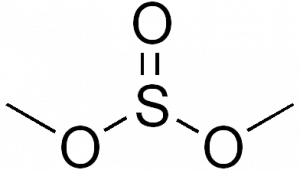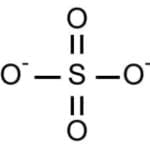Written by: John K. Chen, PhD, PharmD, OMD, LAc
Reviewed by Tina T. Chen, LAc; Donna Chow Sanchez, LAc; and Anita Chen Marshall, DAOM, PharmD, PhD, LAc
Sulfa, sulfite, sulfate, and sulfur are four terms that sound similar but have very different allergy profiles. As healthcare practitioners, it is important to understand these four terms to establish whether patients have true allergy, cross-allergy, or no allergy among drugs, herbs and foods.
Understanding Sulfa Allergies and Cross-Reactivity
1. Sulfa (sulfonamide antimicrobials and sulfonamide non-antimicrobials)

“Sulfa drugs” refers primarily to sulfonamide antimicrobials, such as sulfamethoxazole, sulfisoxazole, sulfafurazole, and sulfadiazine, containing sulfur, oxygen, nitrogen and other groups. Allergic reactions occur due to the actions of sulfonamide antimicrobials, not the actual sulfur. Though 3 to 4% of patients claim to allergic to sulfa drugs, only 3% of these patients have a true allergy to sulfonamide antimicrobials.[1],[2],[3] True hypersensitivity reactions, such as rash and hives, will generally resolve within two weeks after discontinuation of the drug. Severe hypersensitivity reactions, such blistering and mucosal reactions, may require hospitalization.[4],[5],[6]
Sulfonamide non-antimicrobials include drugs such as furosemide, hydrochlorothiazide, acetazolamide, sulfonylureas, and celecoxib. Sulfonamide antimicrobials and sulfonamide non-antimicrobials have different chemical structures, and there is no clinical evidence of cross-allergy.[7],[8]
Sulfonamides were originally derived from red dye. There is no data available to determine whether there is cross-allergy with Chinese herbs that have been used as blue/green dye, such as Ban Lan Gen (Radix isatidis), Da Qing Ye (Folium isatidis) and Qing Dai (Indigo naturalis).
| Table 1. Sulfonamide Antimicrobials |
| Sulfamethoxazole-trimethoprim (Septra, Bactrim) |
| Sulfisoxazole-erythromycin (Pediazole) |
| Table 2. Sulfonamide Non-Antimicrobials |
| Celecoxib (Celebrex) |
| Furosemide (Lasix) |
| Glimepiride (Amaryl) |
| Glyburide (Glynase, Diabeta) |
| Hydrochlorothiazide (Microzide) |
| Sumatriptan (Imitrex) |
If you think a career in holistic medicine is something you would like to pursue, contact us and speak to an admissions representative to get started on your new journey!
The Impact of Sulfites on Allergy Profiles
2. Sulfite

Sulfites are molecules that contain one sulfur atom surrounded by 2 or 3 oxygen atoms. Sulfites occur naturally in some foods during the fermentation process, such as red wine. Sulfites, which can be added as preservatives to prevent food from turning color and bacteria from spoiling foods, are commonly found in foods such as dried fruits (excluding dark raisins and prunes), bottled lemon juice (non-frozen), bottled lime juice (non-frozen), sauerkraut (and its juice), grape juices (white, white sparkling, pink sparkling, red sparkling), salad, and pickled cocktail onions.
Sulfites are also present in many oral medications (adrenaline, isoprenaline, isoproterenol, isoetharine, phenylephrine, dexamethasone and injectable corticosteroids, dopamine, local anaesthetics, propofol, aminoglycoside antibiotics, metoclopramide and doxycycline) and topical creams and ointments (antifungals and corticosteroids). Lastly, many cosmetic products also contain sulfites (hair colors and bleaches, home permanent solutions, skin fading/lighteners, false tan lotions, anti-aging creams and moisturizers, facial cleansers, around-the-eye creams, body washes/cleansers, hair sprays, perfumes, blush, bronzers, and highlighters).[9]
Sulfites are present in many forms including bisulfite, metabisulfite, and sulfur dioxide. Sulfites cause allergy in approximately 1% of population. Hypersensitivity reactions include hives, dyspnea, and in severe cases, anaphylactic shock. Products that contain more than 10 ppm of sulfite require disclosure on the label, according to the US FDA.[10]
Sulfites and sulfonamides have different chemical structures, and there is no evidence of cross-allergy between sulfites and sulfonamides.[11],[12]
For patients with sulfite allergy, inquiry should be made to ensure the seven herbs listed below are sulfite free. Chinese herbs that may be treated with sulfite include: Bai Guo (Semen Ginkgo), Bai He (Bulbus Lilii), Ge Gen (Radix Puerariae Lobatae), Gou Qi Zi (Fructus Lycii), Ren Shen (Radix et Rhizoma Ginseng), Shan Yao (Rhizoma Dioscoreae), Yu Zhu (Rhizoma Polygonati Odorati).
| Table 3. Foods That Contains Sulfites |
| Fruits, dried (excluding dark raisins and prunes) |
| Grape juices (white, white sparkling, pink sparkling, red sparkling) |
| Lemon juice, bottled (non-frozen) |
| Lime juice, bottled (non-frozen) |
| Pickled cocktail onions |
| Salad |
| Sauerkraut (and its juice) |
| Wine |
| Table 4. Drugs That Contains Sulfites |
| Adrenaline |
| Aminoglycoside antibiotics |
| Anaesthetics, local |
| Antifungal (creams and ointments) |
| Corticosteroids (creams and ointments) |
| Corticosteroids (injectable) |
| Dexamethasone |
| Dopamine |
| Doxycycline |
| Isoetharine |
| Isoprenaline |
| Isoproterenol |
| Metoclopramide |
| Phenylephrine |
| Propofol |
| Table 5. Cosmetic Products That Contains Sulfites |
| Anti-aging creams and moisturizers |
| Around-the-eye creams |
| Blush |
| Body washes/cleansers |
| Bronzers and highlighters |
| Facial cleansers |
| False tan lotions |
| Hair colors and bleaches |
| Hair sprays |
| Home permanent solutions |
| Perfumes |
| Skin fading/lighteners |
| Table 6. Herbs That May Contain Sulfites |
| Bai Guo (Semen Ginkgo) |
| Bai He (Bulbus Lilii) |
| Ge Gen (Radix Puerariae Lobatae) |
| Gou Qi Zi (Fructus Lycii) |
| Ren Shen (Radix et Rhizoma Ginseng) |
| Shan Yao (Rhizoma Dioscoreae) |
| Yu Zhu (Rhizoma Polygonati Odorati) |
Sulfates in Everyday Products: A Closer Look
3. Sulfate

Sulfates contain one sulfur atom surrounded by 4 oxygen atoms. Sulfates are widely present in everyday life: sulfate-containing drugs (i.e., ferrous sulfate), dietary supplements (i.e., glucosamine sulfate), and personal care products (i.e., shampoo, toothpaste, shaving foam, body washes and facial cleansers).[13]
Sulfate allergies are rare. In addition, sulfates, again, are different from sulfonamide antimicrobials as well as sulfites and do not cause allergic or sensitivity reactions.
Demystifying Sulfur Allergies: Understanding the Basics
4. Sulfur

Sulfur is a chemical element that is naturally present in many amino acids and other important molecules in the body. In fact, after calcium and phosphorus, it is the third most abundant mineral in the human body. Sulfur is also found in many foods, such as garlic, onions, and broccoli.[14]
While some individuals may be allergic to the action of sulfonamide antimicrobials and sulfites, they do not have true allergy to sulfur itself. True allergy to sulfur is virtually impossible, as sulfur is present in all living tissues and humans cannot survive without it.
Conclusion
Sulfa, sulfite, sulfate, and sulfur are four terms that sound similar but have completely different clinical implications. In addition to inquiring after patients’ allergy profiles, healthcare practitioners must help patients understand the differences between these four terms so patients who have true allergy or cross-allergy with sulfa, sulfites, and/or sulfates can avoid those drugs, herbs, foods, and products.
- Sulfa drugs, specifically sulfonamide antimicrobials, may cause allergy in approximately 3% of the population. There is no clinical evidence of cross-allergy between sulfonamide antimicrobials and sulfonamide non-antimicrobials, or documented evidence of cross-allergy between sulfonamide antimicrobials and Chinese herbs.
- Sulfites, including bisulfite, metabisulfite, and sulfur dioxide, are widely present in foods, dietary supplements, drugs and cosmetic products. There is no evidence of cross-allergy between sulfonamide antimicrobials and sulfites. For patients with true sulfite allergy, seven herbs (listed above) should be tested to ensure they are sulfite-free.
- Sulfates are widely present in everyday life as drugs, dietary supplements, and personal care products. Sulfate allergies are rare. There is no evidence of cross-allergy between sulfates with sulfonamide antimicrobials and sulfites.
- Sulfur is a chemical element that is naturally present in human body and many foods. It is virtually impossible to be allergic to sulfur.
[1] Macy E, Ho NJ. Multiple drug intolerance syndrome: prevalence, clinical characteristics, and management. Ann Allergy Asthma Immunol. 2012;108:88-93.
[2] Strom BL, Schinnar R, Apter AJ, Margolis DJ, Lautenbach E, Hennessy S, et al. Absence of cross-reactivity between sulfonamide antibiotics and sulfonamide nonantibiotics. N Engl J Med. 2003;349:1628–1635.
[3] Slatore CG, Tilles SA. Sulfonamide hypersensitivity. Immunol Allergy Clin N Am. 2004;24:477–490.
[4] Joint Task Force on Practice Parameters, the American Academy of Allergy, Asthma and Immunology, the American College of Allergy, Asthma and Immunology, and the Joint Council of Allergy, Asthma and Immunology. Drug allergy: an updated practice parameter. Ann Allergy Asthma Immunol. 2010;105:259-273.
[5] Zawodniak A, Lochmatter P, Beeler A, Pichler WJ. Cross-reactivity in drug hypersensitivity reactions to sulfasalazine and sulfamethoxazole. Int Arch Allergy Immunol. 2010;153:152-156.
[6] Slatore CG, Tilles SA. Sulfonamide hypersensitivity. Immunol Allergy Clin North Am. 2004;24:477-490.
[7] Hemstreet BA, Page RL 2nd. Sulfonamide allergies and outcomes related to use of potentially cross-reactive drugs in hospitalized patients. Pharmacotherapy. 2006;26:551-557.
[8] Vally H, Misso NL. Adverse reactions to the sulphite additives. Gastroenterol Hepatol Bed Bench. 2012;5:16-23.
[9] Sampson HA, Aceves S, Bock SA, et al. Food allergy: a practice parameter update–2014. J Allergy Clin Immunol. 2014;134:1016-1025.
[10] Wolke, RL. Sulfa-Sulfites Confusion. The Washington Post. October 26, 2005.
[11] Brackett CC, Singh H, Block JH. Likelihood and mechanisms of cross-allergenicity between sulfonamide antibiotics and other drugs containing a sulfonamide functional group. Pharmacotherapy. 2004;24:856-870.
[12] Hemstreet BA, Page RL 2nd. Sulfonamide allergies and outcomes related to use of potentially cross-reactive drugs in hospitalized patients. Pharmacotherapy. 2006;26:551-557.
[13] Dibbern DA Jr, Montanaro A. Allergies to sulfonamide antibiotics and sulfur-containing drugs. Ann Allergy Asthma Immunol. 2008;100:91-100.
[14] Dibbern DA Jr, Montanaro A. Allergies to sulfonamide antibiotics and sulfur-containing drugs. Ann Allergy Asthma Immunol. 2008;100:91-100.
Featured Posts:
- Herbal Treatment in Special Populations
- “Shenocide”: Three Protocols for the Treatment of Psychospiritual Aspects of Opioid Addiction
- Hold that Sneeze: Chinese Medicine for Fall Allergies
- Chinese Medicine Used to Treat Food Allergies
- Over 5,000 Acupuncturists Come Together to Fight Spread of COVID-19
